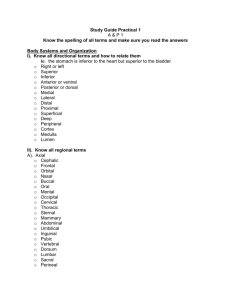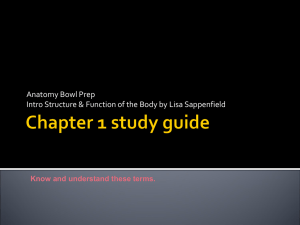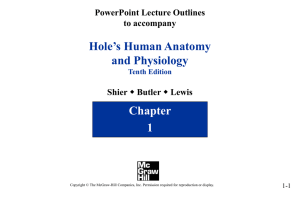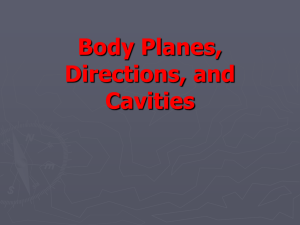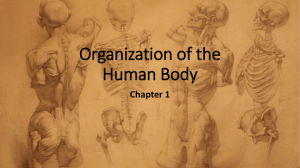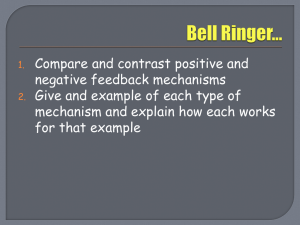Anatomy & Physiology: Terminology, Cavities, Rat Dissection
advertisement
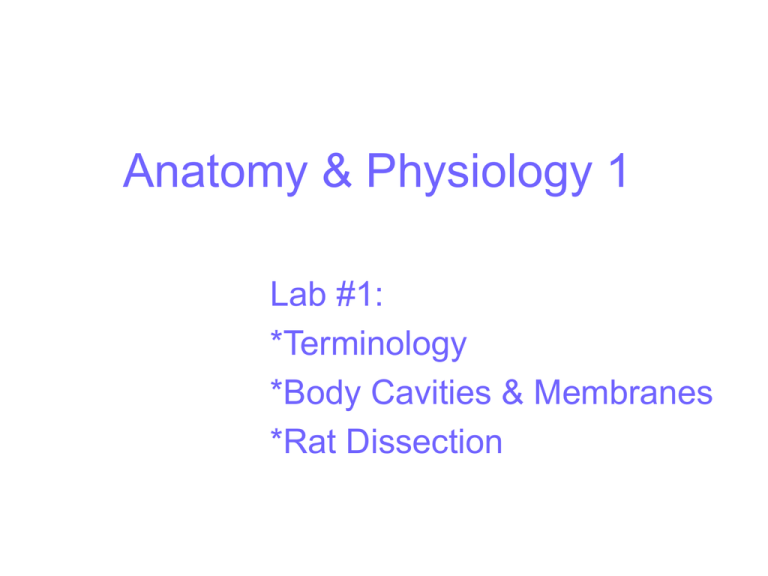
Anatomy & Physiology 1 Lab #1: *Terminology *Body Cavities & Membranes *Rat Dissection Anatomical Position Standard frame of reference for anatomical description & dissection • • • • Person stands erect Feet flat on floor Arms at sides Palms, eyes & face facing forward Anatomical Planes Planes are imaginary flat surfaces passing through the body • Sagittal plane – divides the body into right and left halves • Frontal (coronal) plane – divides the body into front and back portions • Transverse (horizontal) plane – divides the body into upper and lower portions Terms of Position • Superior: upper or above • Inferior: lower or below • Anterior: toward the front • Posterior: toward the back • Cranial: toward the head • Caudal: toward the feet • Ventral: anterior • Dorsal: posterior Terms of Position (cont’d) • Medial: toward the middle (medial plane) • Lateral: away from the middle • Proximal: closer to the point of attachment or origin • Distal: farther from the point of attachment or origin • Supine: facing up • Prone: facing down Forearm Positions • Supine – palms face forward or upward – radius & ulna are parallel • Prone – palms face rearward or downward – radius & ulna are crossed Abdominal References • Quadrants: – RUQ - right upper quadrant – RLQ - right lower quadrant – LUQ - left upper quadrant – LLQ - left lower quadrant Abdominal References Nine Regions – defined by four lines that intersect like a tic-tac-toe grid – Each vertical line is called R or L lateral plane – Superior horizontal line is the transpyloric plane – Inferior horizontal line is the transtubercular plane Nine Regions hypochondriac region epigastric region hypochondriac region Lateral lumbar region umbilical region lateral lumbar region iliac region hypogastric region iliac region Body Cavities • Body cavities are lined with serous membranes • The body is internally divided into two major body cavities, dorsal and ventral • The organs within them are called viscera Dorsal Ventral Dorsal Body Cavity • The dorsal body cavity has two subdivisions: – Cranium Cavity – Vertebral Canal • The dorsal body cavity is lined by three membrane layers called the meninges Ventral Body Cavity • Thoracic Cavity – pleural cavity (lungs) – pericardial cavity (heart) ---------diaphram---------- • Abdominopelvic Cavity – abdominal Cavity – pelvic Cavity Cavities and Membranes • Within the Thoracic Cavity a two-layered membrane called the pericardium encloses the heart and a two-layered membrane called the pleura encloses the lungs • The abdominopelvic cavity contains a membrane called the peritoneum Body Cavity Membranes • Parietal membranes lines the cavity – parietal pleura of the thoracic cavity – parietal pericardium of the heart – parietal peritoneum of the abdominopelvic cavity • Visceral membranes form the external surface of organs – visceral pleura of the lungs – visceral pericardium of the heart – visceral peritoneum of the digestive organs Membrane Cavities • The narrow moist space formed between the visceral and parietal membranes are cavities lubricated with serous fluid – pleural cavity - pleural fluid – pericardial cavity - pericardial fluid – peritoneal cavity - peritoneal fluid Greater and Lesser Omentum • An “apron” which is an extension of the peritoneum; contains adipose tissue • Lesser omentum extends from the liver and covers the stomach • Greater omentum extends from the stomach to the posterior abdominal wall Rat Dissection • • • • Partners: gown, gloves, goggles Wash specimen with soap and place on tray Cut as directed; DON’T BUTCHER! View all the organ structures listed for the practical (do not remove the organs) • Wrap and bag specimen; label


